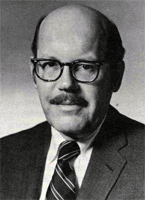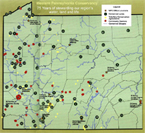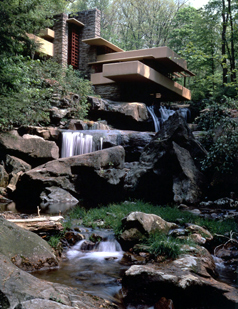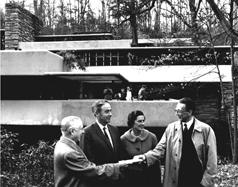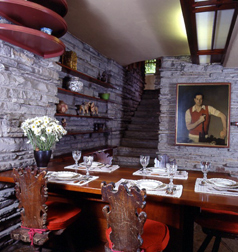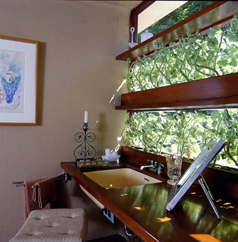|
Conserve |
|
| Conserve 75th Anniversary Commemorative Issue |
| 1930s - 40s |
| 1950s |
| 1960s |
| 1970s |
| 1980s |
| 1990s |
| 2000s |
| Fall 2007 Home |
| Past Issues |
The day Edgar Kaufmann jr. entrusted Fallingwater to the Western Pennsylvania Conservancy was of such national significance that President John F. Kennedy sent the following proclamation to be read on that late October morning of 1963.
"The vigor of Wright's architecture and the richness of Fallingwater's spectacular natural setting combine to form a distinctive public legacy. The nation and especially the people of the Commonwealth of Pennsylvania owe the Kaufmanns a debt of deep gratitude."
One cannot help but attach a sadness to his words, given the historical context that this would be among his last such correspondences.
Today, Fallingwaterris open to the public on Tuesday through Sunday from 10 a.m. to 4 p.m. through the Thanksgiving weekend. In the beginning of December, it is open on weekends only (weather permitting), then open all days between Christmas and New Year's Day.
1960s
FALLINGWATER AND BEAR RUN Another chapter of the WPC’s history, and a story in itself, is Frank Lloyd Wright’s Fallingwater. Voted the most important building of the 20th century in a poll conducted by the American Institute of Architects, this masterpiece was entrusted to the Conservancy by Edgar Kaufmann jr. (sic) in October, 1963. Included with this generous gift were 1,543 acres surrounding the wild and beautiful Bear Run. Fallingwater was built in 1936 by Edgar Kaufmann, Sr., and used as a mountain retreat for his family. The Kaufmanns became acquainted with the Conservancy when they were involved with the early acquisition of Ferncliff Peninsula, later to become the cornerstone of Ohiopyle State Park. Edgar Kaufmann jr commented on the importance of Fallingwater when he said, “Such a place cannot be possessed. It is a work of man for man; not by a man for a man. Over the years since it was built, Fallingwater has grown ever more famous and admired, a textbook example of modern architecture at its best. By its very intensity it is a public resource, not a private indulgence.” Fallingwater came to the Conservancy with its buildings, collections and site intact. Following Mr. Kaufmann’s death in 1989, The New York Times architecture critic Paul Goldberger wrote, “[the gift] constituted one of the grandest and most meaningful gestures of architectural philanthropy of our age.” The donation was received under a deed of trust that requires the Conservancy to preserve and maintain the buildings and when the first year’s visitation was 30,000. Since then visitation has grown steadily. In 2006, more than 136,000 people visited the house and grounds of Fallingwater, and Fallingwater’s total visitation surpassed four million guests since it opened in 1964. The Bear Run Nature Reserve has grown too — it has over tripled in size from its original 1,543 acres. Today, the reserve encompasses almost 70 percent of the Bear Run watershed in its 5,061 acres. The reserve is a place where habitat is The Conservancy’s relationship with Fallingwater can best be summed up in the words of Mr. Kaufmann when he conveyed the house in 1963: “Why are these acres and this house given as a conservation, in the care of Western Pennsylvania Conservancy? Because conservation is not preservation: preservation is stopping life to serve a future contingency; conservation is At the dedication one speaker speculated. “Perhaps one day as many as 25,000 people a year will find their way to this remote mountain location.” You can
imagine the surprise of the Conservancy. I believe the Conservancy will give nature, the source, full due, and art, the human response to nature, full
|
WPC President Charles Lewis (left) accepts the deed for Fallingwater from Edgar Kaufmann jr. (right). Pa. Gov. William Scranton and his wife, Mary, attended the 1963 dedication ceremony.
Color photos by Robert Ruschak |
1961-63 300-acre Wildflower Reserve in Raccoon Creek valley, Beaver County, acquired. Considered by many as the finest stand of native wildflowers in southwestern Pennsylvania. Now owned and operated by Bureau of State Parks.
1963 Fallingwater is entrusted to WPC by Edgar Kaufmann jr. along with 1,543 surrounding acres. Today, the Conservancy protects 5,061 acres on Bear Run Nature Reserve that hosts Frank Lloyd Wright’s masterwork.
1966-69 897 acres in Venango County acquired and transferred to the Commonwealth
of Pennsylvania for creation of Oil Creek State Park.
1966-68 11,230 acres conserved along Laurel Ridge, from the Youghiogheny River to the Conemaugh River, and conveyed to the Commonwealth as a substantial part of Laurel Ridge State Park and the 70 mile Laurel Highlands Hiking Trail.
1969 Joshua C. Whetzel Jr. elected president of the Conservancy, a position he
would hold until 1978 when he became Chairman of the Board of Directors. The Whetzel and Walton families would later donate land and buildings that
would become Beechwood Farms (see 1970s).
